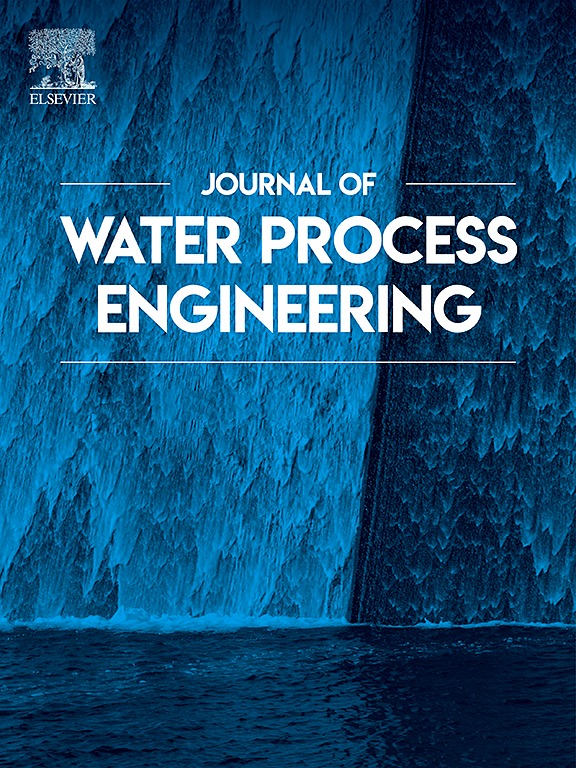Application of mathematical models to predict permeate water quality in pilot- and full-scale reverse osmosis processes
IF 6.3
2区 工程技术
Q1 ENGINEERING, CHEMICAL
引用次数: 0
Abstract
An evaluation that investigated the accuracy and precision of various mathematical models in predicting permeate water quality for pilot- and full-scale reverse osmosis (RO) membrane processes treating brackish ground water containing scale inhibitors has been completed. Process feed, permeate and concentrate were monitored for flow, pressure, and water quality at operating pilot- and full-scale facilities that employed polyamide-based thin-film composite spiral-wound element configurations. The collected information was used to predict water and solute mass transfer using common porous and non-porous mechanistic-based mathematical models. Overall, this study demonstrated the application of 27 models (or model modifications) for predicting the permeate water quality of pilot- and full-scale RO processes using operation information taken directly from utilities' SCADA output data. The solution friction model was observed to be the most accurate in predicting permeate TDS and chloride, partially attributed to its' accurate estimation of the water mass transfer coefficient (MTC) and supported by t-test and Monte Carlo analysis. The solution diffusion method of determining kw-SD, which used the water flux and net driving pressure, was further refined with power and exponential functions to account for performance decline. These functions were generally accurate in predicting the observed water MTC; however, the kw-SD approach proved to be more reliable. The solute mass transfer coefficients were determined experimentally and empirically using the Sherwood number correlation. The constants used for Sherwood number correlations under laminar or turbulent flow conditions typically failed to accurately predict actual solute mass transfer values unless a model-fitting approach was used.
数学模型在中试和全规模反渗透过程中预测渗透水质的应用
研究了各种数学模型在中试和全规模反渗透(RO)膜工艺处理含阻垢剂的微咸地下水时预测渗透水质的准确性和精密度。在采用聚酰胺薄膜复合螺旋缠绕元件配置的中试和全规模设施中,对工艺进料、渗透和浓缩液的流量、压力和水质进行了监测。利用收集到的信息,利用常见的多孔和非多孔力学数学模型预测水和溶质的传递。总体而言,本研究展示了27个模型(或模型修正)的应用,这些模型使用直接从公用事业公司的SCADA输出数据中获取的操作信息来预测中试和全面反渗透过程的渗透水质。结果表明,溶液摩擦模型对渗透率TDS和氯离子的预测最准确,部分原因是其对水传质系数(MTC)的估计较准确,并得到t检验和蒙特卡罗分析的支持。利用水通量和净驱动压力确定kw-SD的溶液扩散法,进一步完善了幂函数和指数函数,以解释性能下降的原因。这些函数对观测水体MTC的预测基本准确;然而,事实证明,kw-SD方法更为可靠。采用舍伍德数相关法对溶质传质系数进行了实验和经验计算。在层流或湍流条件下用于舍伍德数相关的常数通常不能准确地预测实际的溶质传质值,除非采用模型拟合方法。
本文章由计算机程序翻译,如有差异,请以英文原文为准。
求助全文
约1分钟内获得全文
求助全文
来源期刊

Journal of water process engineering
Biochemistry, Genetics and Molecular Biology-Biotechnology
CiteScore
10.70
自引率
8.60%
发文量
846
审稿时长
24 days
期刊介绍:
The Journal of Water Process Engineering aims to publish refereed, high-quality research papers with significant novelty and impact in all areas of the engineering of water and wastewater processing . Papers on advanced and novel treatment processes and technologies are particularly welcome. The Journal considers papers in areas such as nanotechnology and biotechnology applications in water, novel oxidation and separation processes, membrane processes (except those for desalination) , catalytic processes for the removal of water contaminants, sustainable processes, water reuse and recycling, water use and wastewater minimization, integrated/hybrid technology, process modeling of water treatment and novel treatment processes. Submissions on the subject of adsorbents, including standard measurements of adsorption kinetics and equilibrium will only be considered if there is a genuine case for novelty and contribution, for example highly novel, sustainable adsorbents and their use: papers on activated carbon-type materials derived from natural matter, or surfactant-modified clays and related minerals, would not fulfil this criterion. The Journal particularly welcomes contributions involving environmentally, economically and socially sustainable technology for water treatment, including those which are energy-efficient, with minimal or no chemical consumption, and capable of water recycling and reuse that minimizes the direct disposal of wastewater to the aquatic environment. Papers that describe novel ideas for solving issues related to water quality and availability are also welcome, as are those that show the transfer of techniques from other disciplines. The Journal will consider papers dealing with processes for various water matrices including drinking water (except desalination), domestic, urban and industrial wastewaters, in addition to their residues. It is expected that the journal will be of particular relevance to chemical and process engineers working in the field. The Journal welcomes Full Text papers, Short Communications, State-of-the-Art Reviews and Letters to Editors and Case Studies
 求助内容:
求助内容: 应助结果提醒方式:
应助结果提醒方式:


